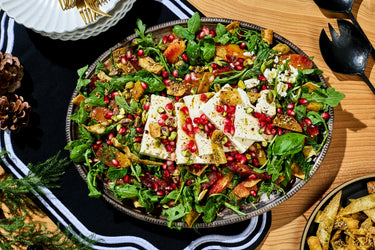6 Clever Ways to Eat More Greens

Here at HexClad, we’re not about rules when it comes to food. (No diet talk; no gimmicks; no nonsense.)
Well, we have maybe one rule: Food should be enjoyed.
So although we don't think greens are "clean," we do think they're delicious–and way more than just something the doctor ordered. With their vibrant color and refreshing texture, they’re a perfect complement to comfort-food staples like mac and cheese or pot roast. Heartier greens can survive being blitzed into creamy pesto or fold seamlessly into your favorite meatball recipe.
And for the cook who hates going to the store every day, greens are a surprisingly long-lasting ingredient to keep in your crisper drawer. So here’s to greens, and all the ways to eat more of them.
1. TUCK GREENS INTO LASAGNA
Lasagna is the perfect place to tuck some sautéed spinach, Swiss chard or any cooked greens you like. Layer a cup or two of chopped, cooked greens between the béchamel and ragù in our ultimate recipe, or blend puréed spinach into a ricotta filling for an herbaceous boost. (Snag details on a ricotta version of the lasagna here). These additions not only add a fresh touch of color, they also deepen the flavor of every cheesy, saucy bite.
2. FOLD ‘EM INTO SAUCY PASTAS
No pasta needs greens, but we’d argue they deliver just the right contrast in texture and flavor. Take our Creamy Skillet Gnocchi with Chicken and Artichokes, for example, in which kale melts right into the garlicky Parmesan cream sauce. You can use this approach with any pasta that has a rich pan sauce: Just cook your greens first to release any extra water, then toss them in with the pasta as you finish the dish.

3. BLEND HEARTY GREENS INTO A SILKY PESTO
The secret to a silky-smooth kale pesto is all about technique. Blanching the leaves briefly in boiling water helps mellow out the earthiness, making the greens pliable enough to puree seamlessly. In our Creamy Kale and Ricotta Pasta, for instance, kale pesto provides a fresh, plant-based contrast to the creamy ricotta. If you want a heartier, cheese-forward pesto, just add some Parmesan to the food processor and adjust the oil for a smooth, rich texture. The result? A versatile pesto that’s at once comforting and vibrant.
4. NESTLE LEAFY GREENS INTO YOUR CALZONES
A calzone offers all the best pizza elements without the mess, plus it’s a natural fit for greens, which can sometimes wilt awkwardly on top of a pizza. In our Giant Calzone recipe, fold chopped, cooked spinach into a Parmesan-ricotta filling for a creamy, savory mixture with just the right amount of green. Not a fan of spinach? Try blanched kale or sautéed radicchio, both of which deliver texture and a slightly bitter bite. (Pro tip: Be sure to squeeze any excess liquid from the greens before adding to the filling to keep the dough from getting soggy.)

5. CONTRAST RICH DISHES WITH BITTER GREENS
When a rich dish has you craving a little bitter balance, greens are here to deliver. Sautéed garlicky kale, for example, makes a perfect pairing for something like osso buco, cutting through the richness with just the right bite. Or try our crisp Winter Citrus and Burrata Salad; the bitter greens and citrus flavors offset heavier dishes with a refreshing lift. For those who like to mix in a bit of crunch with their mac and cheese, greens add welcome texture, too. Visually, they lend a burst of color to the plate, creating a spread that looks as vibrant as it tastes.
6. STIR HEARTY GREENS INTO SOUPS
Few dishes embrace greens as seamlessly as soups and stews. Toward the end of cooking your favorite chili, bean stew or vegetable soup, add in a handful of chopped kale, Swiss chard or spinach for a hit of color and an added layer of flavor. Greens lend a subtle, fresh contrast to the warmth of a rich broth, keeping things lively without overshadowing the main ingredients. Bonus: They maintain their texture beautifully, even in leftovers, retaining just the right balance and heartiness when you go back for a second bowl.
The point is, greens aren’t just an afterthought or something we “should” eat. Here’s to cooking greener, tastier dishes and getting rid of food “shoulds,” to boot.





